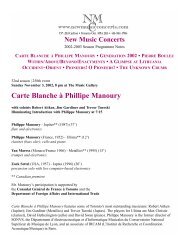2004-2005 Season The Hammerhead Consort - New Music Concerts
2004-2005 Season The Hammerhead Consort - New Music Concerts
2004-2005 Season The Hammerhead Consort - New Music Concerts
You also want an ePaper? Increase the reach of your titles
YUMPU automatically turns print PDFs into web optimized ePapers that Google loves.
I transposed these ideas, which were stimulated by his words, into the musical domain, and concentrated<br />
transforming the concepts to another plane whereby seeking the process to make a new dimension in music. I<br />
found the sound of the Shô would realize this idea because of its transcending possibilities for the subtlest<br />
differentiation of sensitive color and tone. It evokes all different senses (such as temperature, visual sense,<br />
auditory sense) which awaken awareness in our consciousness.<br />
Commissioned by Mayumi Miyata and dedicated to her.<br />
— Kazuhiko Suzuki<br />
John Cage was born on September 5, 1912 in Los Angeles, California and died in <strong>New</strong> York City on August<br />
12, 1992. He studied liberal arts at Pomona College. Among his composition teachers were Henry Cowell and<br />
Arnold Schoenberg. Cage was elected to the American National Academy and Institute of Arts and Letters and<br />
received innumerable awards and honors both in the United States and in Europe. He was commissioned by a<br />
great many of the most important performing organizations throughout the world, and maintained a very active<br />
schedule. It would be extremely difficult to calculate, let alone critically evaluate, the stimulating effect and<br />
ramifications that Cage’s work has had on 20th century music and art, for it is clear that the musical<br />
developments of our time cannot be understood without taking into account his music and ideas. His invention<br />
of the prepared piano and his work with percussion instruments led him to imagine and explore many unique<br />
and fascinating ways of structuring the temporal dimension of music. He is universally recognized as the<br />
initiator and leading figure in the field of indeterminate composition by means of chance operations. Arnold<br />
Schoenberg said of Cage that he was an “inventor – of genius”.<br />
John Cage — One9 (1991)<br />
(courtesy Edition Peters)<br />
As he approached his eightieth birthday, John Cage found himself the grand old man of the avant-garde, a<br />
composer, writer, and artist who had attained notoriety and visibility on a worldwide scale. Once only a small<br />
circle of brilliant performers had been associated with his work; now ensembles and soloists awarded him<br />
commission after commission for new compositions. In order to keep up with the demand for new pieces,<br />
Cage turned once more to his long-time assistant Andrew Culver, who developed new software that enabled<br />
Cage to write music very quickly.<br />
<strong>The</strong>se new works, which occupied almost all of Cage’s compositional attention between 1987 and 1992, came<br />
to be known as the Number Pieces. Each work’s title consists only of a number written out as a word (One,<br />
Two, Fourteen, etc.) that indicates the number of performers for which the piece was composed.<br />
…the Number Pieces generally alternate simple pitches and even conventional chords with inexplicable noises<br />
and dissonances. <strong>The</strong> transparency that characterizes most of the works in the series even allows us to pay<br />
attention — with an unusual level of awareness — to the attacks of sounds, their tunings, or their particular<br />
timbre. All in all, they demonstrate Cage’s quiet reconciliation with harmony, which he now defined as<br />
“several sounds . . . being noticed at the same time.” Cage first met Mayumi Miyata during his historic return




